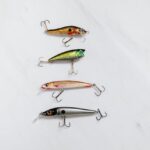The Art of Saltwater Jigging: A Guide
Saltwater jigging is a popular fishing technique that involves using a weighted lure, or jig, to imitate the movements of baitfish and attract predatory fish. It’s a versatile technique that can be used to catch a wide variety of species in both shallow and deep waters. In this guide, we’ll cover the basics of saltwater jigging, including gear, technique, and some tips and tricks for successful jigging.
Gear
The first step in saltwater jigging is to make sure you have the right gear. Here’s a breakdown of the essential equipment you’ll need:
- Rod: A good jigging rod should be stiff and strong enough to handle the weight of the jig and the force of the fish. Look for a rod with a fast action and a heavy power rating, typically in the range of 30-80 pounds. A shorter rod, around 5-6 feet, is best for vertical jigging, while a longer rod, around 7-8 feet, is better for horizontal jigging.
- Reel: A high-quality reel with a smooth drag system is essential for saltwater jigging. Look for a reel with a high gear ratio, which will allow you to quickly retrieve the jig and react to bites.
- Line: Braided line is the best choice for saltwater jigging, as it’s strong, sensitive, and has low stretch. Look for a line with a test weight that matches the rod and reel you’re using, typically in the range of 30-80 pounds.
- Jigs: Jigs come in a variety of shapes, sizes, and colors, and it’s important to choose the right one for the species you’re targeting and the conditions you’re fishing in. Heavy jigs, around 4-6 ounces, are best for deep water, while lighter jigs, around 1-2 ounces, are better for shallow water. Colors that mimic the local baitfish are often the most effective.
Technique
Now that you have your gear, it’s time to learn the basics of saltwater jigging technique. Here’s a step-by-step guide:
- Find the right spot: Look for areas with structure, such as rocks, reefs, or drop-offs, where predatory fish are likely to be feeding. Use a fishfinder or ask local anglers for advice.
- Drop the jig: Lower the jig to the bottom or to the desired depth, depending on the species you’re targeting and the conditions you’re fishing in. Use the reel to control the descent of the jig.
- Jig the lure: Once the jig is at the desired depth, start jigging the lure by rapidly lifting and dropping the rod tip. Vary the speed and depth of the jig to imitate the movements of baitfish and attract bites. You can also try different jigging patterns, such as long sweeps or short hops, to find what works best.
- Set the hook: When you feel a bite, quickly reel in the slack and set the hook with a sharp upward motion of the rod. It’s important to set the hook firmly to avoid losing the fish.
Tips and Tricks
Here are some additional tips and tricks for successful saltwater jigging:
- Be patient: Saltwater jigging can require patience, as it may take time to find the right spot and the right technique for the species you’re targeting.
- Use a leader: A fluorocarbon leader can help prevent the fish from seeing the line and increase your chances of a hookup.
- Pay attention to the weather: The weather can have a big impact on saltwater jigging. Calm, overcast days are often the most productive, while windy or stormy days can make it difficult to control the jig.
- Match the hatch: Matching the color and size of your jig to the local baitfish can be highly effective in attracting predatory fish.
- Experiment with different jigs: Don’t be afraid to try out different shapes, sizes, and colors of jigs to find what works best for the species you’re targeting and the conditions you’re fishing in.
- Use a jigging assist hook: A jigging assist hook can increase your hookup rate by providing an additional hook point for the fish to latch onto.
- Use a vertical jigging technique: Vertical jigging can be highly effective for targeting fish in deep water. Drop the jig to the bottom and then rapidly lift and drop the rod tip to attract bites.
- Try slow-pitch jigging: Slow-pitch jigging is a newer technique that involves using a slow, deliberate motion to imitate the movements of baitfish. It can be highly effective for targeting finicky fish.
- Pay attention to the tide: The tide can have a big impact on saltwater jigging. Look for areas with strong currents and fish the incoming or outgoing tide.
- Keep your gear organized: Saltwater jigging can involve a lot of gear, so it’s important to keep everything organized and easily accessible. Use a tackle bag or box to store your jigs, leader material, pliers, and other accessories.
In conclusion, saltwater jigging is a versatile and effective fishing technique that can be used to catch a wide variety of species in both shallow and deep waters. With the right gear, technique, and a little patience, you can become a successful saltwater jigging angler. Don’t be afraid to experiment with different jigs, colors, and techniques to find what works best for you. And always remember to follow local fishing regulations and practice catch-and-release whenever possible to help preserve our marine resources for future generations.






